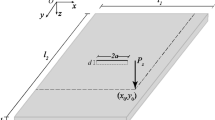Abstract
The paper presents the results of a numerical study of forced and decaying vibrations of a system simulating a body with a closing crack under the action of various modes of a nonlinear restoring force and nonlinear viscous friction or the hysteresis-type energy dissipation. We obtained the general patterns of appearance of higher harmonics of the Fourier expansion of time dependence of vibration of a cracked body model. The sensitivity of the higher-harmonic method to the presence of a crack is compared with that of some other vibration damage indicators.
Similar content being viewed by others
References
M. Krawczuk and W. Ostachowicz, “Damage indicators for diagnostics of fatigue cracks in structures by vibration measurements—a survey,”J. Theor. Appl. Mech.,34, No. 2, 307–326 (1996).
A. A. Hochrein and L. L. Yeager, “Computer-assisted digital processing system for a nondestructive evaluation technique utilizing the phenomenon of internal friction,” in: Proc. of the Fract. Mech. Symp. Naval Structure Mechanics (1978), pp. 67–73.
A. Rytter, R. Brincker, and P. H. Kirkegaard, “An experimental study of the modal parameters of a damaged cantilever,”, in:Fracture and Dynamics, Paper N 37, Dept. of Building Technology and Structural Engineering, University of Aalborg (1992).
D. Afolabi, “An anti-resonance technique for detecting structural damage,” in: Proc. of the 5th IMAC, London (1987), pp. 491–495.
W. Ostachowicz and M. Krawczuk, “Vibration analysis of a cracked beam,”Comput. Struct.,36, 245–250 (1990).
K. R. Collins, R. H. Plaut, and J. Wauer, “Free and forced longitudinal vibrations of a cantilever bar with a crack,”ASME J. Vibr., Acoust., Stress, Reliab. Des.,114, 171–177 (1992).
S. L. Tsyfanskii, M. A. Magone, and V. M. Ozhiganov, “On the use of nonlinear effects for detecting cracks in bar-shaped structural elements,”Defektoskopiya, No. 3, 77–85 (1985).
S. L. Tsyfanskii, V. I. Beresnevich, and M. A. Magone, “Vibration diagnostics of fatigue cracks in aircraft bearing surfaces by using nonlinear effects,”Defektoskopiya, No. 2, 87–94 (1993).
G. Diana, N. Bachschmid, and F. Angel, “An on-line crack detection method for turbo generator rotors,” in: Proc. of Int. Conf. on Rotor-dynamics, JSME (1980), pp. 385–390.
V. A. Karasev and A. B. Roitman,Development of Machinery in Operation. Vibration Diagnostics Methods [in Russian], Mashinostroenie, Moscow (1986).
V. P. Golub, V. P. Butseroga, and A. D. Pogrebnyak, “A study of kinetics of fatigue cracks by a method of differential compliance,”Prikl. Mekh.,31, No. 12, 66–73 (1995).
V. V. Matveev, “On analysis of efficiency of the method of spectral vibrodiagnostics of fatigue damage of structural elements. Part 1. Longitudinal Vibrations. Analytical solution”,Probl. Prochn., No. 6, 5–20 (1997).
N. G. Shulzhenko, G. B. Ovcharova, and V. P. Biletchenko, “Calculation of vibration characteristics of a multiple-bearing rotor with a transverse crack under small static strains,”Probl. Prochn., No. 2, 92–99 (1996).
B. I. Kryukov,Dynamics of Resonance-Type Vibration Machines [in Russian], Naukova Dumka, Kiev (1967).
N. N. Davidenkov, “Review. On enrgy dissipation in vibrations,”Zh. Tekh. Fiz.,8, issue 6, 483–499 (1938).
V. V. Matveev, “On description of the mechanical-hysteresis loop,”Probl. Prochn., No. 8, 3–9 (1973).
S. Macabe and H. Kaneshiro, “Measurement of crack closure points during cyclic loading by the strain interference method,”Eng. Fract. Mech.,43, No. 6, 993–1002 (1992).
A. B. Roitman, A. A. Pylov, and N. B. Aleksandrova, “Development of efficient methods of vibration diagnostics of fatigue damage of critical structural elements. Part 1. Longitudinal vibrations,”Probl. Prochn., No. 2, 23–35 (1999).
I. I. Blekhman (Ed.),Vibrations in Engineering. Handbook in 6 Volumes. Volume 2:Vibrations of Nonlinear Mechanical Systems [in Russian], Mashinostroenie, Moscow (1979).
S. P. Timoshenko, D. H. Young, and W. Weever,Vibrations in Engineering [in Russian], Mashinostroenie, Moscow (1985).
A. P. Bovsunovskii, “On determination of natural frequency of transverse and longitudinal vibration of a cracked beam. Part 2. Experimental and calculation results,”Probl. Prochn., No. 3, 45–53 (1999).
A. P. Bovsunovskii, “Comparative analysis of sensitivity of vibration damage indicators by the results of laboratory tests,” in: Proc. Int. Conf. on Modal Analysis, Kissimmee, Florida (1999), pp. 467–473.
Additional information
Institute of Problems of Strength, National Academy of Sciences of Ukraine, Kiev, Ukraine. Translated from Problemy Prochnosti, No. 6, pp. 65–80, November–December, 1999.
Rights and permissions
About this article
Cite this article
Bovsunovskii, A.P. Numerical study of vibrations of a nonlinear mechanical system simulating a cracked body. Strength Mater 31, 571–581 (1999). https://doi.org/10.1007/BF02510893
Received:
Issue Date:
DOI: https://doi.org/10.1007/BF02510893




